Organisational Behaviour Report: Culture, Communication, and Success
VerifiedAdded on 2023/01/10
|11
|3197
|97
Report
AI Summary
This report delves into the realm of organisational behaviour, exploring its multifaceted impact on workplace dynamics. Focusing on Tesco, the report examines the influence of organisational culture, communication strategies, and motivational theories on employee performance and overall success. It identifies organisational culture through the lens of theoretical models, such as Hofstede's cultural dimensions, and analyses how culture enhances organisational effectiveness by improving communication. Furthermore, the report investigates the role of culture in employee motivation, utilizing content and process theories like Maslow's hierarchy of needs and Vroom's expectancy theory. The report concludes by highlighting how a strong organisational culture can be leveraged to enhance organisational success, offering valuable insights for effective leadership and management practices.
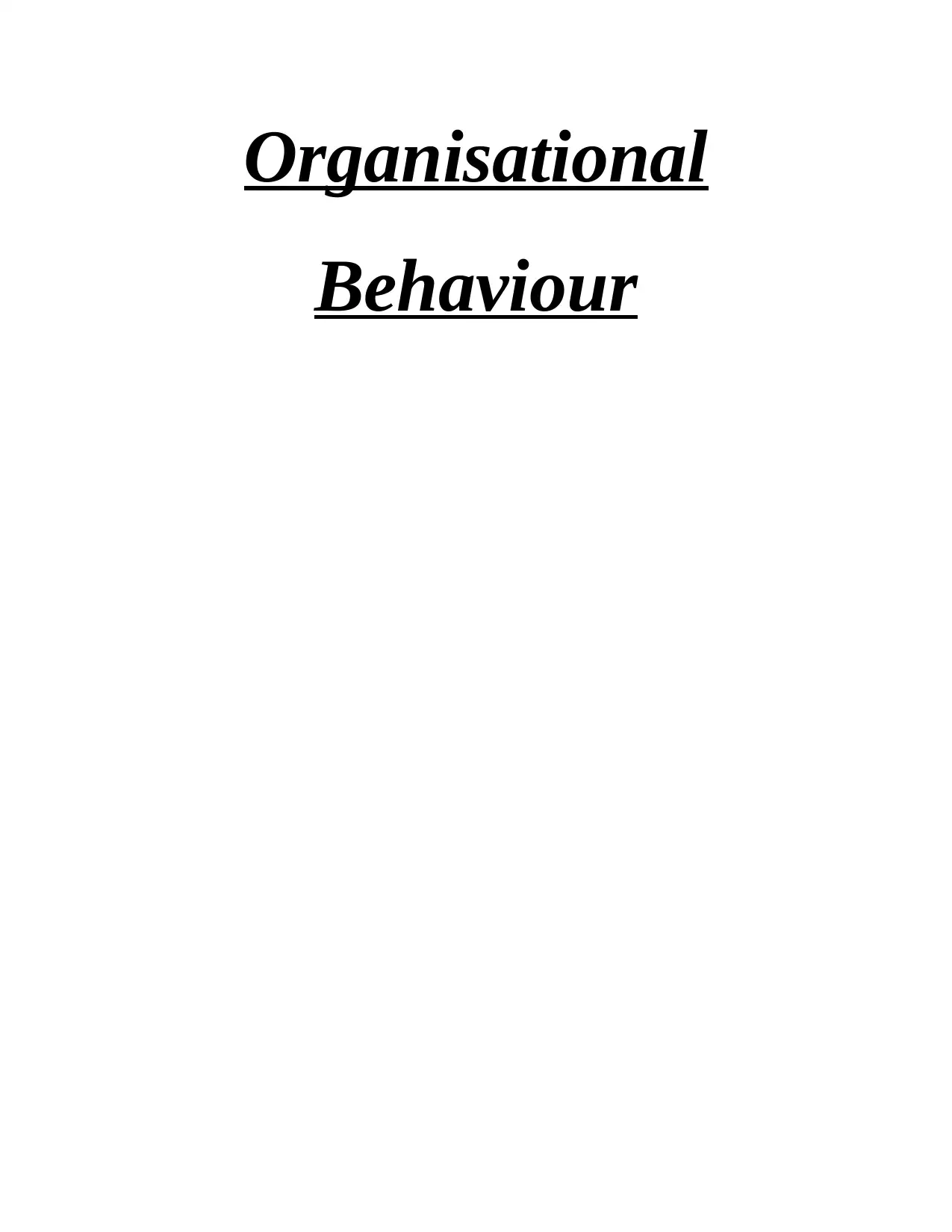
Organisational
Behaviour
Behaviour
Paraphrase This Document
Need a fresh take? Get an instant paraphrase of this document with our AI Paraphraser
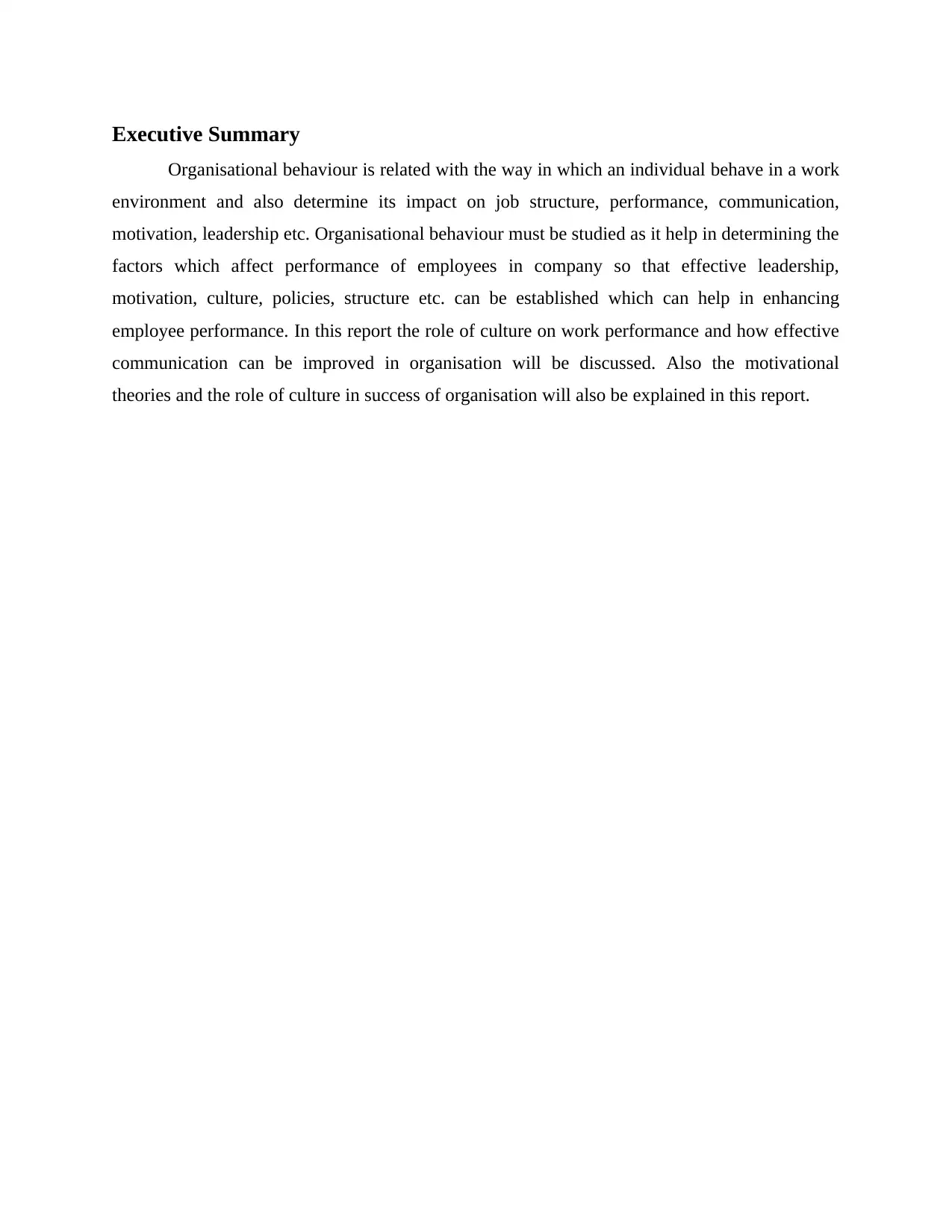
Executive Summary
Organisational behaviour is related with the way in which an individual behave in a work
environment and also determine its impact on job structure, performance, communication,
motivation, leadership etc. Organisational behaviour must be studied as it help in determining the
factors which affect performance of employees in company so that effective leadership,
motivation, culture, policies, structure etc. can be established which can help in enhancing
employee performance. In this report the role of culture on work performance and how effective
communication can be improved in organisation will be discussed. Also the motivational
theories and the role of culture in success of organisation will also be explained in this report.
Organisational behaviour is related with the way in which an individual behave in a work
environment and also determine its impact on job structure, performance, communication,
motivation, leadership etc. Organisational behaviour must be studied as it help in determining the
factors which affect performance of employees in company so that effective leadership,
motivation, culture, policies, structure etc. can be established which can help in enhancing
employee performance. In this report the role of culture on work performance and how effective
communication can be improved in organisation will be discussed. Also the motivational
theories and the role of culture in success of organisation will also be explained in this report.
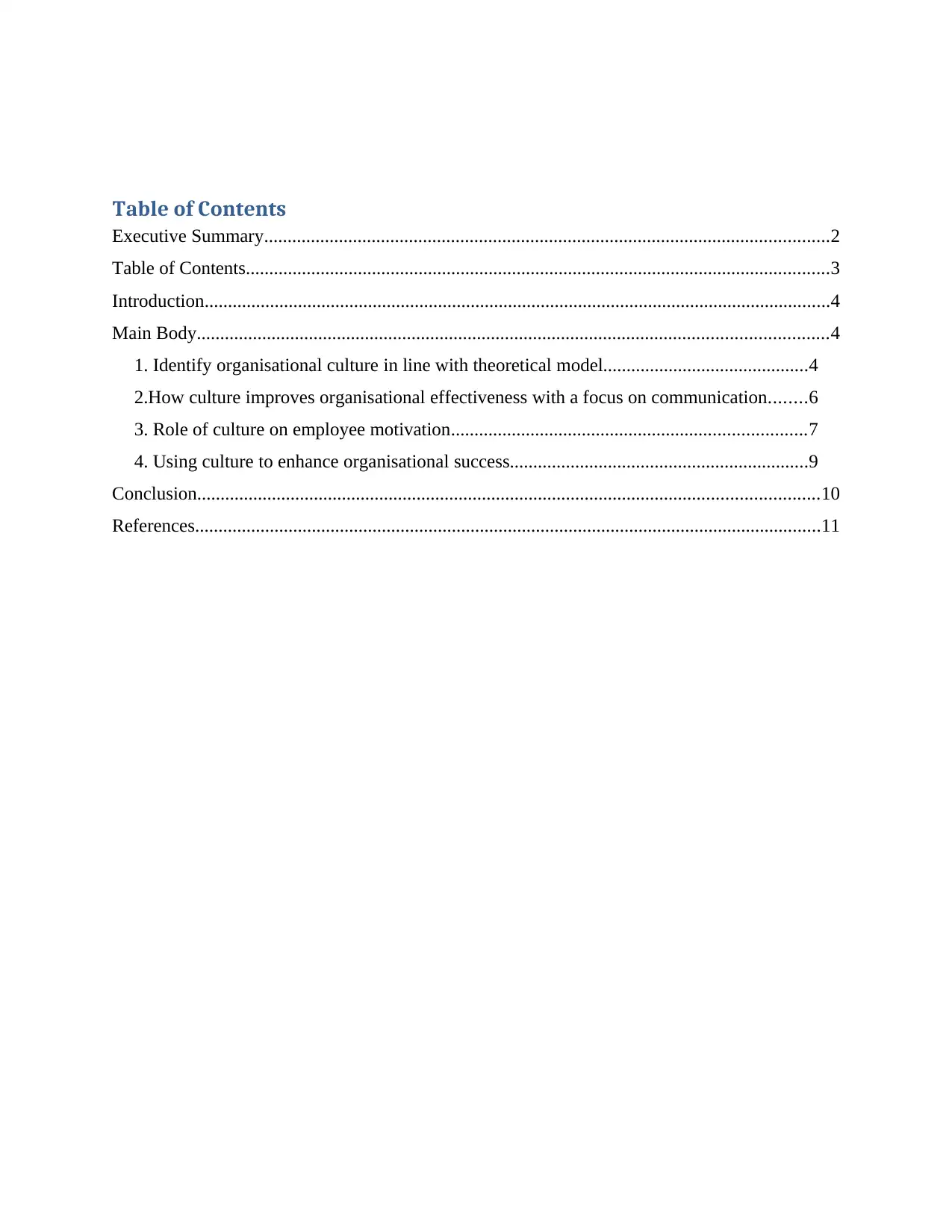
Table of Contents
Executive Summary.........................................................................................................................2
Table of Contents.............................................................................................................................3
Introduction......................................................................................................................................4
Main Body.......................................................................................................................................4
1. Identify organisational culture in line with theoretical model............................................4
2.How culture improves organisational effectiveness with a focus on communication........6
3. Role of culture on employee motivation............................................................................7
4. Using culture to enhance organisational success................................................................9
Conclusion.....................................................................................................................................10
References......................................................................................................................................11
Executive Summary.........................................................................................................................2
Table of Contents.............................................................................................................................3
Introduction......................................................................................................................................4
Main Body.......................................................................................................................................4
1. Identify organisational culture in line with theoretical model............................................4
2.How culture improves organisational effectiveness with a focus on communication........6
3. Role of culture on employee motivation............................................................................7
4. Using culture to enhance organisational success................................................................9
Conclusion.....................................................................................................................................10
References......................................................................................................................................11
⊘ This is a preview!⊘
Do you want full access?
Subscribe today to unlock all pages.

Trusted by 1+ million students worldwide
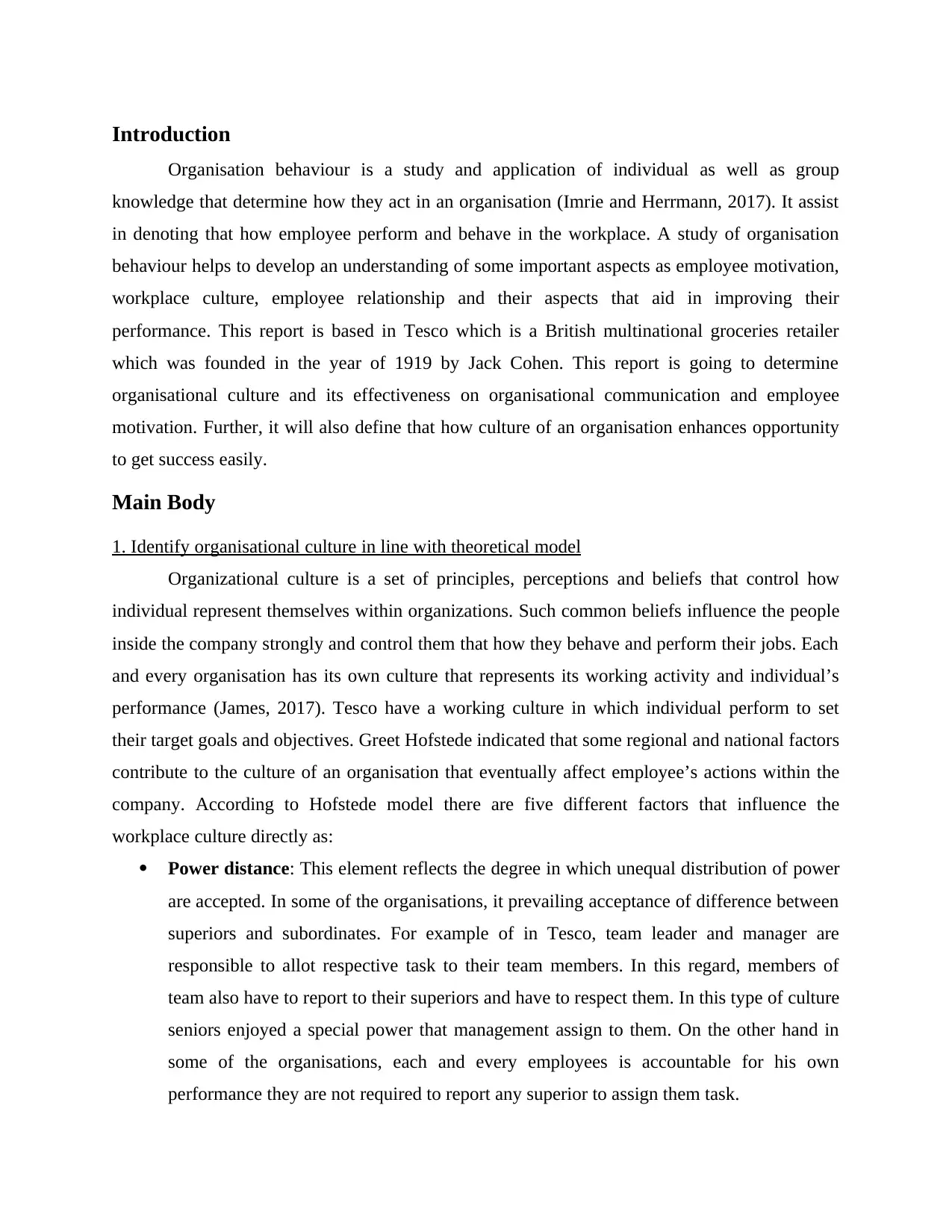
Introduction
Organisation behaviour is a study and application of individual as well as group
knowledge that determine how they act in an organisation (Imrie and Herrmann, 2017). It assist
in denoting that how employee perform and behave in the workplace. A study of organisation
behaviour helps to develop an understanding of some important aspects as employee motivation,
workplace culture, employee relationship and their aspects that aid in improving their
performance. This report is based in Tesco which is a British multinational groceries retailer
which was founded in the year of 1919 by Jack Cohen. This report is going to determine
organisational culture and its effectiveness on organisational communication and employee
motivation. Further, it will also define that how culture of an organisation enhances opportunity
to get success easily.
Main Body
1. Identify organisational culture in line with theoretical model
Organizational culture is a set of principles, perceptions and beliefs that control how
individual represent themselves within organizations. Such common beliefs influence the people
inside the company strongly and control them that how they behave and perform their jobs. Each
and every organisation has its own culture that represents its working activity and individual’s
performance (James, 2017). Tesco have a working culture in which individual perform to set
their target goals and objectives. Greet Hofstede indicated that some regional and national factors
contribute to the culture of an organisation that eventually affect employee’s actions within the
company. According to Hofstede model there are five different factors that influence the
workplace culture directly as:
Power distance: This element reflects the degree in which unequal distribution of power
are accepted. In some of the organisations, it prevailing acceptance of difference between
superiors and subordinates. For example of in Tesco, team leader and manager are
responsible to allot respective task to their team members. In this regard, members of
team also have to report to their superiors and have to respect them. In this type of culture
seniors enjoyed a special power that management assign to them. On the other hand in
some of the organisations, each and every employees is accountable for his own
performance they are not required to report any superior to assign them task.
Organisation behaviour is a study and application of individual as well as group
knowledge that determine how they act in an organisation (Imrie and Herrmann, 2017). It assist
in denoting that how employee perform and behave in the workplace. A study of organisation
behaviour helps to develop an understanding of some important aspects as employee motivation,
workplace culture, employee relationship and their aspects that aid in improving their
performance. This report is based in Tesco which is a British multinational groceries retailer
which was founded in the year of 1919 by Jack Cohen. This report is going to determine
organisational culture and its effectiveness on organisational communication and employee
motivation. Further, it will also define that how culture of an organisation enhances opportunity
to get success easily.
Main Body
1. Identify organisational culture in line with theoretical model
Organizational culture is a set of principles, perceptions and beliefs that control how
individual represent themselves within organizations. Such common beliefs influence the people
inside the company strongly and control them that how they behave and perform their jobs. Each
and every organisation has its own culture that represents its working activity and individual’s
performance (James, 2017). Tesco have a working culture in which individual perform to set
their target goals and objectives. Greet Hofstede indicated that some regional and national factors
contribute to the culture of an organisation that eventually affect employee’s actions within the
company. According to Hofstede model there are five different factors that influence the
workplace culture directly as:
Power distance: This element reflects the degree in which unequal distribution of power
are accepted. In some of the organisations, it prevailing acceptance of difference between
superiors and subordinates. For example of in Tesco, team leader and manager are
responsible to allot respective task to their team members. In this regard, members of
team also have to report to their superiors and have to respect them. In this type of culture
seniors enjoyed a special power that management assign to them. On the other hand in
some of the organisations, each and every employees is accountable for his own
performance they are not required to report any superior to assign them task.
Paraphrase This Document
Need a fresh take? Get an instant paraphrase of this document with our AI Paraphraser
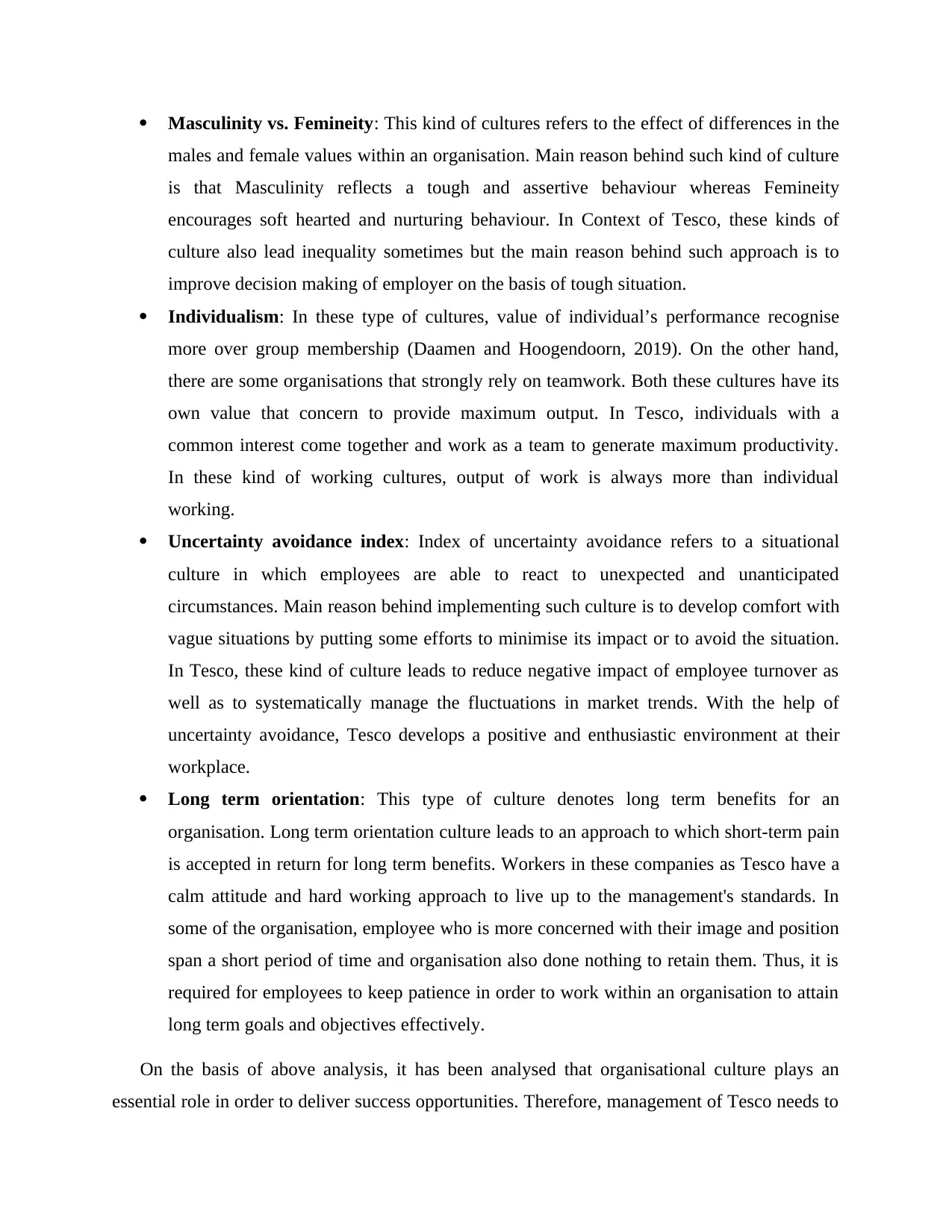
Masculinity vs. Femineity: This kind of cultures refers to the effect of differences in the
males and female values within an organisation. Main reason behind such kind of culture
is that Masculinity reflects a tough and assertive behaviour whereas Femineity
encourages soft hearted and nurturing behaviour. In Context of Tesco, these kinds of
culture also lead inequality sometimes but the main reason behind such approach is to
improve decision making of employer on the basis of tough situation.
Individualism: In these type of cultures, value of individual’s performance recognise
more over group membership (Daamen and Hoogendoorn, 2019). On the other hand,
there are some organisations that strongly rely on teamwork. Both these cultures have its
own value that concern to provide maximum output. In Tesco, individuals with a
common interest come together and work as a team to generate maximum productivity.
In these kind of working cultures, output of work is always more than individual
working.
Uncertainty avoidance index: Index of uncertainty avoidance refers to a situational
culture in which employees are able to react to unexpected and unanticipated
circumstances. Main reason behind implementing such culture is to develop comfort with
vague situations by putting some efforts to minimise its impact or to avoid the situation.
In Tesco, these kind of culture leads to reduce negative impact of employee turnover as
well as to systematically manage the fluctuations in market trends. With the help of
uncertainty avoidance, Tesco develops a positive and enthusiastic environment at their
workplace.
Long term orientation: This type of culture denotes long term benefits for an
organisation. Long term orientation culture leads to an approach to which short-term pain
is accepted in return for long term benefits. Workers in these companies as Tesco have a
calm attitude and hard working approach to live up to the management's standards. In
some of the organisation, employee who is more concerned with their image and position
span a short period of time and organisation also done nothing to retain them. Thus, it is
required for employees to keep patience in order to work within an organisation to attain
long term goals and objectives effectively.
On the basis of above analysis, it has been analysed that organisational culture plays an
essential role in order to deliver success opportunities. Therefore, management of Tesco needs to
males and female values within an organisation. Main reason behind such kind of culture
is that Masculinity reflects a tough and assertive behaviour whereas Femineity
encourages soft hearted and nurturing behaviour. In Context of Tesco, these kinds of
culture also lead inequality sometimes but the main reason behind such approach is to
improve decision making of employer on the basis of tough situation.
Individualism: In these type of cultures, value of individual’s performance recognise
more over group membership (Daamen and Hoogendoorn, 2019). On the other hand,
there are some organisations that strongly rely on teamwork. Both these cultures have its
own value that concern to provide maximum output. In Tesco, individuals with a
common interest come together and work as a team to generate maximum productivity.
In these kind of working cultures, output of work is always more than individual
working.
Uncertainty avoidance index: Index of uncertainty avoidance refers to a situational
culture in which employees are able to react to unexpected and unanticipated
circumstances. Main reason behind implementing such culture is to develop comfort with
vague situations by putting some efforts to minimise its impact or to avoid the situation.
In Tesco, these kind of culture leads to reduce negative impact of employee turnover as
well as to systematically manage the fluctuations in market trends. With the help of
uncertainty avoidance, Tesco develops a positive and enthusiastic environment at their
workplace.
Long term orientation: This type of culture denotes long term benefits for an
organisation. Long term orientation culture leads to an approach to which short-term pain
is accepted in return for long term benefits. Workers in these companies as Tesco have a
calm attitude and hard working approach to live up to the management's standards. In
some of the organisation, employee who is more concerned with their image and position
span a short period of time and organisation also done nothing to retain them. Thus, it is
required for employees to keep patience in order to work within an organisation to attain
long term goals and objectives effectively.
On the basis of above analysis, it has been analysed that organisational culture plays an
essential role in order to deliver success opportunities. Therefore, management of Tesco needs to
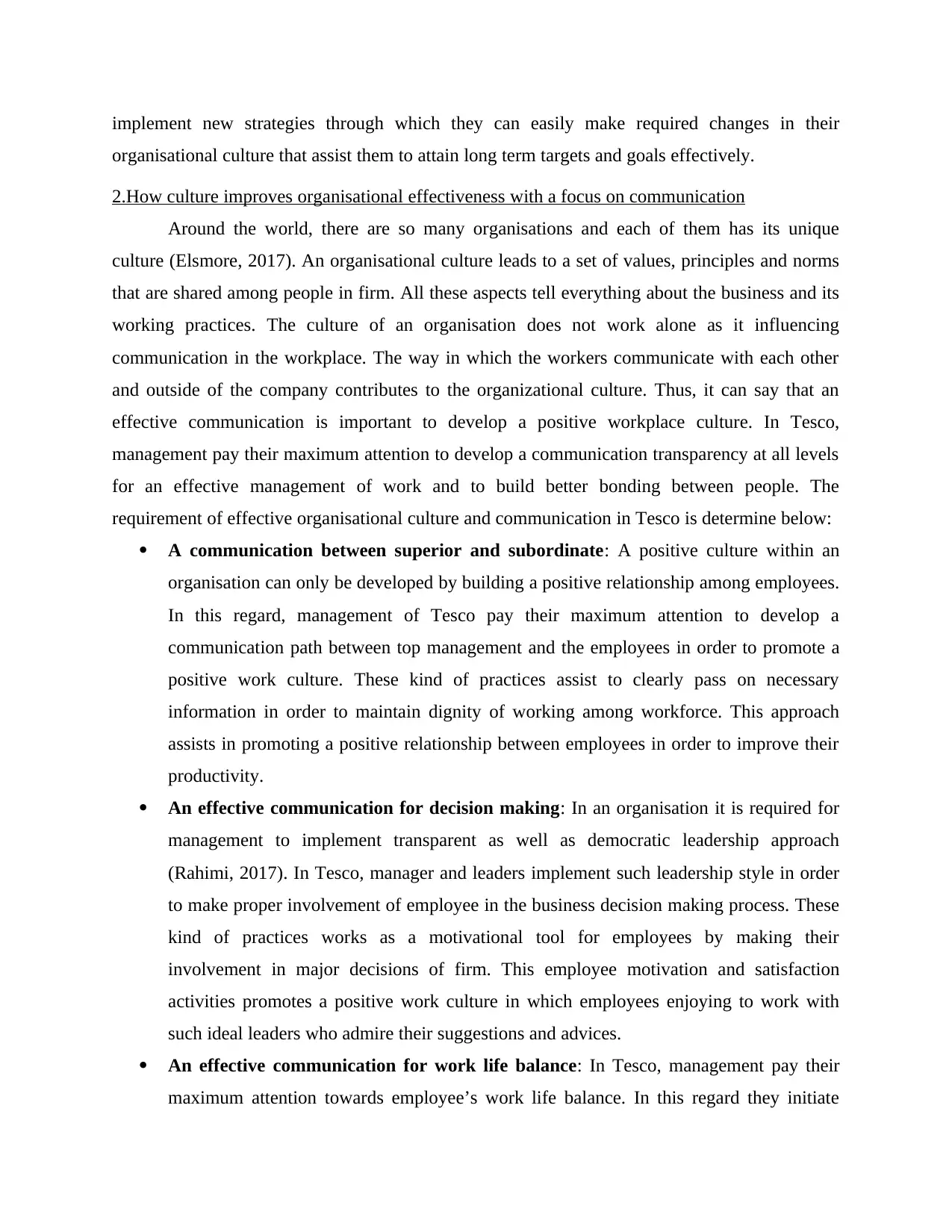
implement new strategies through which they can easily make required changes in their
organisational culture that assist them to attain long term targets and goals effectively.
2.How culture improves organisational effectiveness with a focus on communication
Around the world, there are so many organisations and each of them has its unique
culture (Elsmore, 2017). An organisational culture leads to a set of values, principles and norms
that are shared among people in firm. All these aspects tell everything about the business and its
working practices. The culture of an organisation does not work alone as it influencing
communication in the workplace. The way in which the workers communicate with each other
and outside of the company contributes to the organizational culture. Thus, it can say that an
effective communication is important to develop a positive workplace culture. In Tesco,
management pay their maximum attention to develop a communication transparency at all levels
for an effective management of work and to build better bonding between people. The
requirement of effective organisational culture and communication in Tesco is determine below:
A communication between superior and subordinate: A positive culture within an
organisation can only be developed by building a positive relationship among employees.
In this regard, management of Tesco pay their maximum attention to develop a
communication path between top management and the employees in order to promote a
positive work culture. These kind of practices assist to clearly pass on necessary
information in order to maintain dignity of working among workforce. This approach
assists in promoting a positive relationship between employees in order to improve their
productivity.
An effective communication for decision making: In an organisation it is required for
management to implement transparent as well as democratic leadership approach
(Rahimi, 2017). In Tesco, manager and leaders implement such leadership style in order
to make proper involvement of employee in the business decision making process. These
kind of practices works as a motivational tool for employees by making their
involvement in major decisions of firm. This employee motivation and satisfaction
activities promotes a positive work culture in which employees enjoying to work with
such ideal leaders who admire their suggestions and advices.
An effective communication for work life balance: In Tesco, management pay their
maximum attention towards employee’s work life balance. In this regard they initiate
organisational culture that assist them to attain long term targets and goals effectively.
2.How culture improves organisational effectiveness with a focus on communication
Around the world, there are so many organisations and each of them has its unique
culture (Elsmore, 2017). An organisational culture leads to a set of values, principles and norms
that are shared among people in firm. All these aspects tell everything about the business and its
working practices. The culture of an organisation does not work alone as it influencing
communication in the workplace. The way in which the workers communicate with each other
and outside of the company contributes to the organizational culture. Thus, it can say that an
effective communication is important to develop a positive workplace culture. In Tesco,
management pay their maximum attention to develop a communication transparency at all levels
for an effective management of work and to build better bonding between people. The
requirement of effective organisational culture and communication in Tesco is determine below:
A communication between superior and subordinate: A positive culture within an
organisation can only be developed by building a positive relationship among employees.
In this regard, management of Tesco pay their maximum attention to develop a
communication path between top management and the employees in order to promote a
positive work culture. These kind of practices assist to clearly pass on necessary
information in order to maintain dignity of working among workforce. This approach
assists in promoting a positive relationship between employees in order to improve their
productivity.
An effective communication for decision making: In an organisation it is required for
management to implement transparent as well as democratic leadership approach
(Rahimi, 2017). In Tesco, manager and leaders implement such leadership style in order
to make proper involvement of employee in the business decision making process. These
kind of practices works as a motivational tool for employees by making their
involvement in major decisions of firm. This employee motivation and satisfaction
activities promotes a positive work culture in which employees enjoying to work with
such ideal leaders who admire their suggestions and advices.
An effective communication for work life balance: In Tesco, management pay their
maximum attention towards employee’s work life balance. In this regard they initiate
⊘ This is a preview!⊘
Do you want full access?
Subscribe today to unlock all pages.

Trusted by 1+ million students worldwide
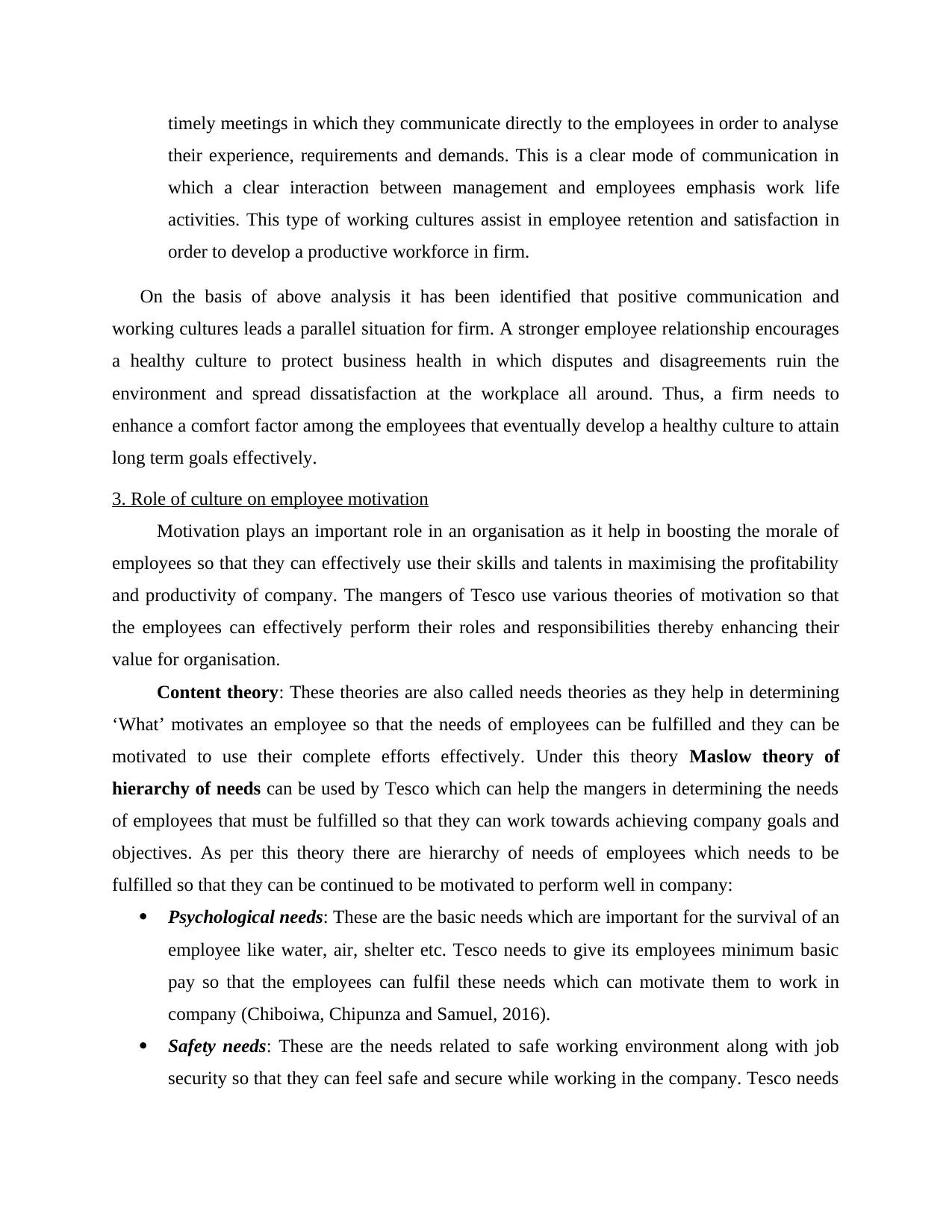
timely meetings in which they communicate directly to the employees in order to analyse
their experience, requirements and demands. This is a clear mode of communication in
which a clear interaction between management and employees emphasis work life
activities. This type of working cultures assist in employee retention and satisfaction in
order to develop a productive workforce in firm.
On the basis of above analysis it has been identified that positive communication and
working cultures leads a parallel situation for firm. A stronger employee relationship encourages
a healthy culture to protect business health in which disputes and disagreements ruin the
environment and spread dissatisfaction at the workplace all around. Thus, a firm needs to
enhance a comfort factor among the employees that eventually develop a healthy culture to attain
long term goals effectively.
3. Role of culture on employee motivation
Motivation plays an important role in an organisation as it help in boosting the morale of
employees so that they can effectively use their skills and talents in maximising the profitability
and productivity of company. The mangers of Tesco use various theories of motivation so that
the employees can effectively perform their roles and responsibilities thereby enhancing their
value for organisation.
Content theory: These theories are also called needs theories as they help in determining
‘What’ motivates an employee so that the needs of employees can be fulfilled and they can be
motivated to use their complete efforts effectively. Under this theory Maslow theory of
hierarchy of needs can be used by Tesco which can help the mangers in determining the needs
of employees that must be fulfilled so that they can work towards achieving company goals and
objectives. As per this theory there are hierarchy of needs of employees which needs to be
fulfilled so that they can be continued to be motivated to perform well in company:
Psychological needs: These are the basic needs which are important for the survival of an
employee like water, air, shelter etc. Tesco needs to give its employees minimum basic
pay so that the employees can fulfil these needs which can motivate them to work in
company (Chiboiwa, Chipunza and Samuel, 2016).
Safety needs: These are the needs related to safe working environment along with job
security so that they can feel safe and secure while working in the company. Tesco needs
their experience, requirements and demands. This is a clear mode of communication in
which a clear interaction between management and employees emphasis work life
activities. This type of working cultures assist in employee retention and satisfaction in
order to develop a productive workforce in firm.
On the basis of above analysis it has been identified that positive communication and
working cultures leads a parallel situation for firm. A stronger employee relationship encourages
a healthy culture to protect business health in which disputes and disagreements ruin the
environment and spread dissatisfaction at the workplace all around. Thus, a firm needs to
enhance a comfort factor among the employees that eventually develop a healthy culture to attain
long term goals effectively.
3. Role of culture on employee motivation
Motivation plays an important role in an organisation as it help in boosting the morale of
employees so that they can effectively use their skills and talents in maximising the profitability
and productivity of company. The mangers of Tesco use various theories of motivation so that
the employees can effectively perform their roles and responsibilities thereby enhancing their
value for organisation.
Content theory: These theories are also called needs theories as they help in determining
‘What’ motivates an employee so that the needs of employees can be fulfilled and they can be
motivated to use their complete efforts effectively. Under this theory Maslow theory of
hierarchy of needs can be used by Tesco which can help the mangers in determining the needs
of employees that must be fulfilled so that they can work towards achieving company goals and
objectives. As per this theory there are hierarchy of needs of employees which needs to be
fulfilled so that they can be continued to be motivated to perform well in company:
Psychological needs: These are the basic needs which are important for the survival of an
employee like water, air, shelter etc. Tesco needs to give its employees minimum basic
pay so that the employees can fulfil these needs which can motivate them to work in
company (Chiboiwa, Chipunza and Samuel, 2016).
Safety needs: These are the needs related to safe working environment along with job
security so that they can feel safe and secure while working in the company. Tesco needs
Paraphrase This Document
Need a fresh take? Get an instant paraphrase of this document with our AI Paraphraser
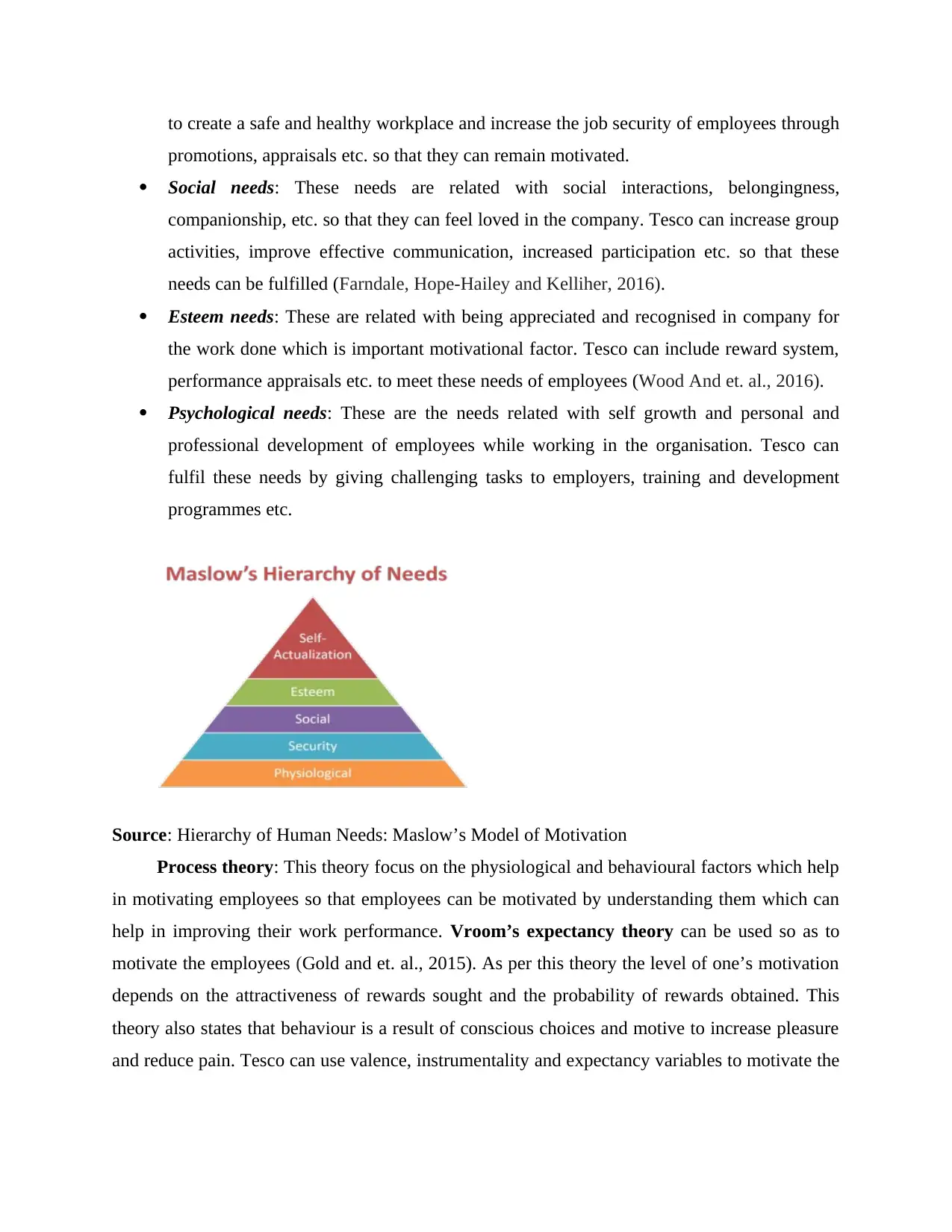
to create a safe and healthy workplace and increase the job security of employees through
promotions, appraisals etc. so that they can remain motivated.
Social needs: These needs are related with social interactions, belongingness,
companionship, etc. so that they can feel loved in the company. Tesco can increase group
activities, improve effective communication, increased participation etc. so that these
needs can be fulfilled (Farndale, Hope-Hailey and Kelliher, 2016).
Esteem needs: These are related with being appreciated and recognised in company for
the work done which is important motivational factor. Tesco can include reward system,
performance appraisals etc. to meet these needs of employees (Wood And et. al., 2016).
Psychological needs: These are the needs related with self growth and personal and
professional development of employees while working in the organisation. Tesco can
fulfil these needs by giving challenging tasks to employers, training and development
programmes etc.
Source: Hierarchy of Human Needs: Maslow’s Model of Motivation
Process theory: This theory focus on the physiological and behavioural factors which help
in motivating employees so that employees can be motivated by understanding them which can
help in improving their work performance. Vroom’s expectancy theory can be used so as to
motivate the employees (Gold and et. al., 2015). As per this theory the level of one’s motivation
depends on the attractiveness of rewards sought and the probability of rewards obtained. This
theory also states that behaviour is a result of conscious choices and motive to increase pleasure
and reduce pain. Tesco can use valence, instrumentality and expectancy variables to motivate the
promotions, appraisals etc. so that they can remain motivated.
Social needs: These needs are related with social interactions, belongingness,
companionship, etc. so that they can feel loved in the company. Tesco can increase group
activities, improve effective communication, increased participation etc. so that these
needs can be fulfilled (Farndale, Hope-Hailey and Kelliher, 2016).
Esteem needs: These are related with being appreciated and recognised in company for
the work done which is important motivational factor. Tesco can include reward system,
performance appraisals etc. to meet these needs of employees (Wood And et. al., 2016).
Psychological needs: These are the needs related with self growth and personal and
professional development of employees while working in the organisation. Tesco can
fulfil these needs by giving challenging tasks to employers, training and development
programmes etc.
Source: Hierarchy of Human Needs: Maslow’s Model of Motivation
Process theory: This theory focus on the physiological and behavioural factors which help
in motivating employees so that employees can be motivated by understanding them which can
help in improving their work performance. Vroom’s expectancy theory can be used so as to
motivate the employees (Gold and et. al., 2015). As per this theory the level of one’s motivation
depends on the attractiveness of rewards sought and the probability of rewards obtained. This
theory also states that behaviour is a result of conscious choices and motive to increase pleasure
and reduce pain. Tesco can use valence, instrumentality and expectancy variables to motivate the
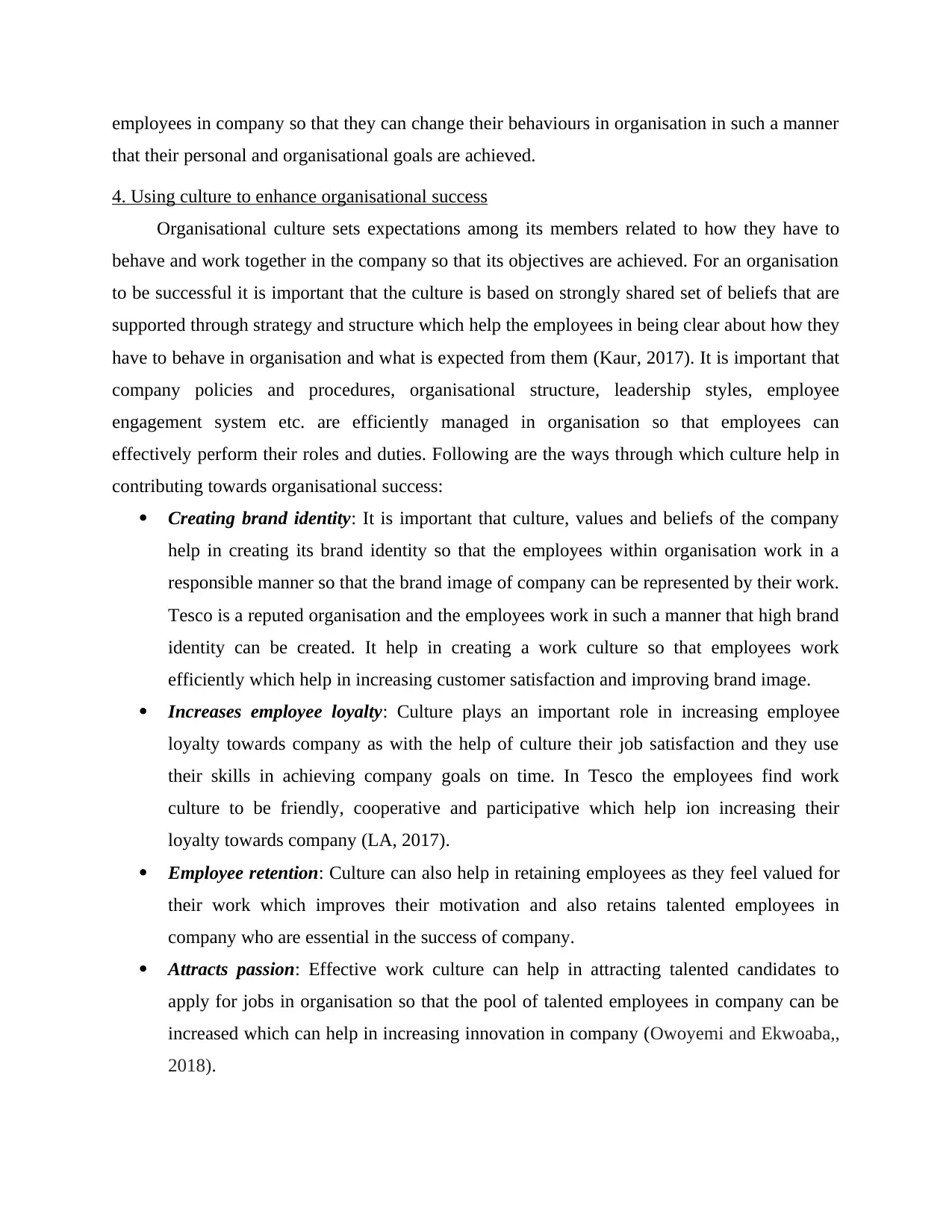
employees in company so that they can change their behaviours in organisation in such a manner
that their personal and organisational goals are achieved.
4. Using culture to enhance organisational success
Organisational culture sets expectations among its members related to how they have to
behave and work together in the company so that its objectives are achieved. For an organisation
to be successful it is important that the culture is based on strongly shared set of beliefs that are
supported through strategy and structure which help the employees in being clear about how they
have to behave in organisation and what is expected from them (Kaur, 2017). It is important that
company policies and procedures, organisational structure, leadership styles, employee
engagement system etc. are efficiently managed in organisation so that employees can
effectively perform their roles and duties. Following are the ways through which culture help in
contributing towards organisational success:
Creating brand identity: It is important that culture, values and beliefs of the company
help in creating its brand identity so that the employees within organisation work in a
responsible manner so that the brand image of company can be represented by their work.
Tesco is a reputed organisation and the employees work in such a manner that high brand
identity can be created. It help in creating a work culture so that employees work
efficiently which help in increasing customer satisfaction and improving brand image.
Increases employee loyalty: Culture plays an important role in increasing employee
loyalty towards company as with the help of culture their job satisfaction and they use
their skills in achieving company goals on time. In Tesco the employees find work
culture to be friendly, cooperative and participative which help ion increasing their
loyalty towards company (LA, 2017).
Employee retention: Culture can also help in retaining employees as they feel valued for
their work which improves their motivation and also retains talented employees in
company who are essential in the success of company.
Attracts passion: Effective work culture can help in attracting talented candidates to
apply for jobs in organisation so that the pool of talented employees in company can be
increased which can help in increasing innovation in company (Owoyemi and Ekwoaba,,
2018).
that their personal and organisational goals are achieved.
4. Using culture to enhance organisational success
Organisational culture sets expectations among its members related to how they have to
behave and work together in the company so that its objectives are achieved. For an organisation
to be successful it is important that the culture is based on strongly shared set of beliefs that are
supported through strategy and structure which help the employees in being clear about how they
have to behave in organisation and what is expected from them (Kaur, 2017). It is important that
company policies and procedures, organisational structure, leadership styles, employee
engagement system etc. are efficiently managed in organisation so that employees can
effectively perform their roles and duties. Following are the ways through which culture help in
contributing towards organisational success:
Creating brand identity: It is important that culture, values and beliefs of the company
help in creating its brand identity so that the employees within organisation work in a
responsible manner so that the brand image of company can be represented by their work.
Tesco is a reputed organisation and the employees work in such a manner that high brand
identity can be created. It help in creating a work culture so that employees work
efficiently which help in increasing customer satisfaction and improving brand image.
Increases employee loyalty: Culture plays an important role in increasing employee
loyalty towards company as with the help of culture their job satisfaction and they use
their skills in achieving company goals on time. In Tesco the employees find work
culture to be friendly, cooperative and participative which help ion increasing their
loyalty towards company (LA, 2017).
Employee retention: Culture can also help in retaining employees as they feel valued for
their work which improves their motivation and also retains talented employees in
company who are essential in the success of company.
Attracts passion: Effective work culture can help in attracting talented candidates to
apply for jobs in organisation so that the pool of talented employees in company can be
increased which can help in increasing innovation in company (Owoyemi and Ekwoaba,,
2018).
⊘ This is a preview!⊘
Do you want full access?
Subscribe today to unlock all pages.

Trusted by 1+ million students worldwide
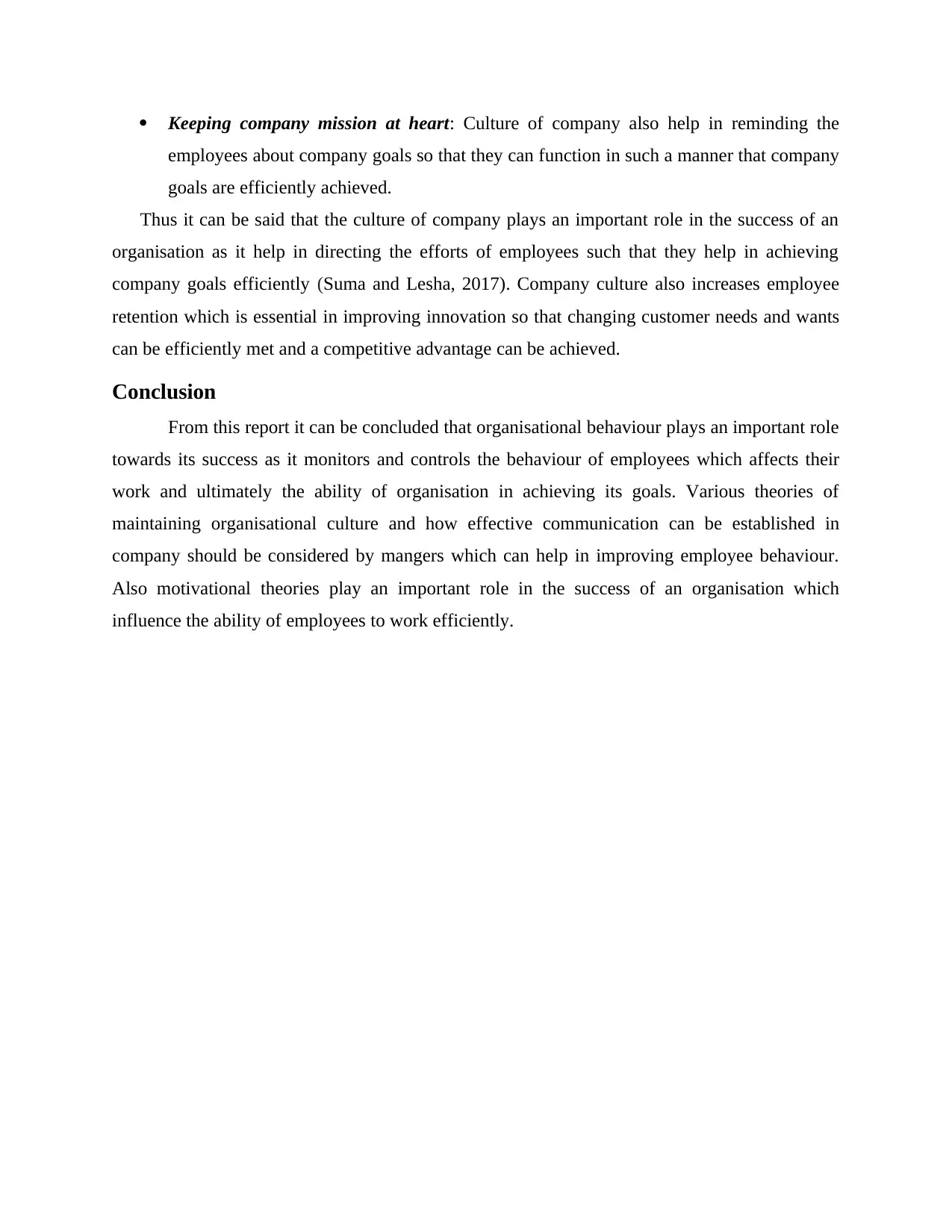
Keeping company mission at heart: Culture of company also help in reminding the
employees about company goals so that they can function in such a manner that company
goals are efficiently achieved.
Thus it can be said that the culture of company plays an important role in the success of an
organisation as it help in directing the efforts of employees such that they help in achieving
company goals efficiently (Suma and Lesha, 2017). Company culture also increases employee
retention which is essential in improving innovation so that changing customer needs and wants
can be efficiently met and a competitive advantage can be achieved.
Conclusion
From this report it can be concluded that organisational behaviour plays an important role
towards its success as it monitors and controls the behaviour of employees which affects their
work and ultimately the ability of organisation in achieving its goals. Various theories of
maintaining organisational culture and how effective communication can be established in
company should be considered by mangers which can help in improving employee behaviour.
Also motivational theories play an important role in the success of an organisation which
influence the ability of employees to work efficiently.
employees about company goals so that they can function in such a manner that company
goals are efficiently achieved.
Thus it can be said that the culture of company plays an important role in the success of an
organisation as it help in directing the efforts of employees such that they help in achieving
company goals efficiently (Suma and Lesha, 2017). Company culture also increases employee
retention which is essential in improving innovation so that changing customer needs and wants
can be efficiently met and a competitive advantage can be achieved.
Conclusion
From this report it can be concluded that organisational behaviour plays an important role
towards its success as it monitors and controls the behaviour of employees which affects their
work and ultimately the ability of organisation in achieving its goals. Various theories of
maintaining organisational culture and how effective communication can be established in
company should be considered by mangers which can help in improving employee behaviour.
Also motivational theories play an important role in the success of an organisation which
influence the ability of employees to work efficiently.
Paraphrase This Document
Need a fresh take? Get an instant paraphrase of this document with our AI Paraphraser
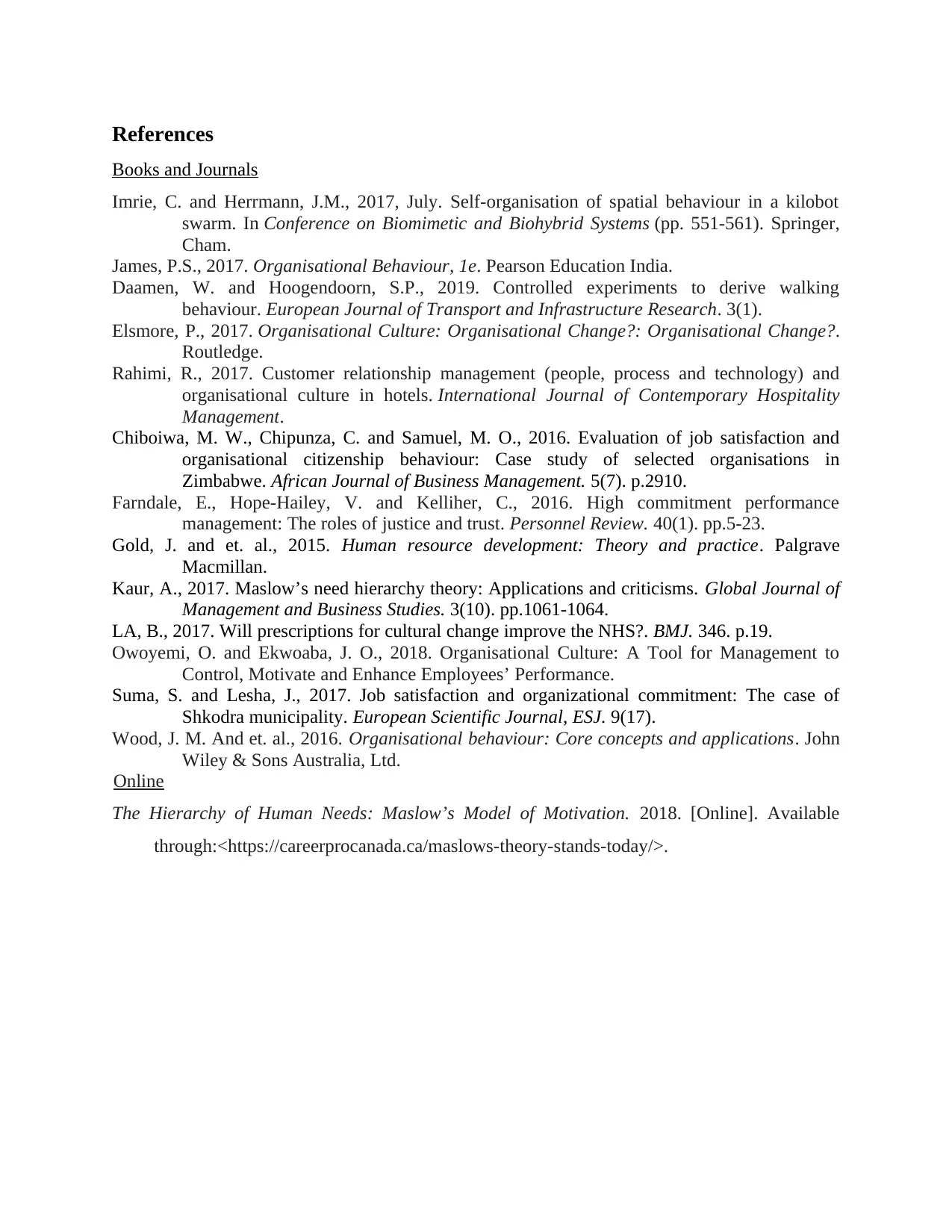
References
Books and Journals
Imrie, C. and Herrmann, J.M., 2017, July. Self-organisation of spatial behaviour in a kilobot
swarm. In Conference on Biomimetic and Biohybrid Systems (pp. 551-561). Springer,
Cham.
James, P.S., 2017. Organisational Behaviour, 1e. Pearson Education India.
Daamen, W. and Hoogendoorn, S.P., 2019. Controlled experiments to derive walking
behaviour. European Journal of Transport and Infrastructure Research. 3(1).
Elsmore, P., 2017. Organisational Culture: Organisational Change?: Organisational Change?.
Routledge.
Rahimi, R., 2017. Customer relationship management (people, process and technology) and
organisational culture in hotels. International Journal of Contemporary Hospitality
Management.
Chiboiwa, M. W., Chipunza, C. and Samuel, M. O., 2016. Evaluation of job satisfaction and
organisational citizenship behaviour: Case study of selected organisations in
Zimbabwe. African Journal of Business Management. 5(7). p.2910.
Farndale, E., Hope-Hailey, V. and Kelliher, C., 2016. High commitment performance
management: The roles of justice and trust. Personnel Review. 40(1). pp.5-23.
Gold, J. and et. al., 2015. Human resource development: Theory and practice. Palgrave
Macmillan.
Kaur, A., 2017. Maslow’s need hierarchy theory: Applications and criticisms. Global Journal of
Management and Business Studies. 3(10). pp.1061-1064.
LA, B., 2017. Will prescriptions for cultural change improve the NHS?. BMJ. 346. p.19.
Owoyemi, O. and Ekwoaba, J. O., 2018. Organisational Culture: A Tool for Management to
Control, Motivate and Enhance Employees’ Performance.
Suma, S. and Lesha, J., 2017. Job satisfaction and organizational commitment: The case of
Shkodra municipality. European Scientific Journal, ESJ. 9(17).
Wood, J. M. And et. al., 2016. Organisational behaviour: Core concepts and applications. John
Wiley & Sons Australia, Ltd.
Online
The Hierarchy of Human Needs: Maslow’s Model of Motivation. 2018. [Online]. Available
through:<https://careerprocanada.ca/maslows-theory-stands-today/>.
Books and Journals
Imrie, C. and Herrmann, J.M., 2017, July. Self-organisation of spatial behaviour in a kilobot
swarm. In Conference on Biomimetic and Biohybrid Systems (pp. 551-561). Springer,
Cham.
James, P.S., 2017. Organisational Behaviour, 1e. Pearson Education India.
Daamen, W. and Hoogendoorn, S.P., 2019. Controlled experiments to derive walking
behaviour. European Journal of Transport and Infrastructure Research. 3(1).
Elsmore, P., 2017. Organisational Culture: Organisational Change?: Organisational Change?.
Routledge.
Rahimi, R., 2017. Customer relationship management (people, process and technology) and
organisational culture in hotels. International Journal of Contemporary Hospitality
Management.
Chiboiwa, M. W., Chipunza, C. and Samuel, M. O., 2016. Evaluation of job satisfaction and
organisational citizenship behaviour: Case study of selected organisations in
Zimbabwe. African Journal of Business Management. 5(7). p.2910.
Farndale, E., Hope-Hailey, V. and Kelliher, C., 2016. High commitment performance
management: The roles of justice and trust. Personnel Review. 40(1). pp.5-23.
Gold, J. and et. al., 2015. Human resource development: Theory and practice. Palgrave
Macmillan.
Kaur, A., 2017. Maslow’s need hierarchy theory: Applications and criticisms. Global Journal of
Management and Business Studies. 3(10). pp.1061-1064.
LA, B., 2017. Will prescriptions for cultural change improve the NHS?. BMJ. 346. p.19.
Owoyemi, O. and Ekwoaba, J. O., 2018. Organisational Culture: A Tool for Management to
Control, Motivate and Enhance Employees’ Performance.
Suma, S. and Lesha, J., 2017. Job satisfaction and organizational commitment: The case of
Shkodra municipality. European Scientific Journal, ESJ. 9(17).
Wood, J. M. And et. al., 2016. Organisational behaviour: Core concepts and applications. John
Wiley & Sons Australia, Ltd.
Online
The Hierarchy of Human Needs: Maslow’s Model of Motivation. 2018. [Online]. Available
through:<https://careerprocanada.ca/maslows-theory-stands-today/>.
1 out of 11
Related Documents
Your All-in-One AI-Powered Toolkit for Academic Success.
+13062052269
info@desklib.com
Available 24*7 on WhatsApp / Email
![[object Object]](/_next/static/media/star-bottom.7253800d.svg)
Unlock your academic potential
Copyright © 2020–2025 A2Z Services. All Rights Reserved. Developed and managed by ZUCOL.




